Top Books Of 2017
The 6 books that defined my year.
2017 was a struggle. It seemed as if every event in the news was designed to prove that that those of us bold enough to believe in the goodness of humanity are ludicrous. To cope with the turmoil of 2017, I abandoned the negativity-driven daily news cycle and shifted my source of information to books that look at the large picture spanning years or decades. Remarkably, what I found was not a downward spiral accelerating in the 21st century, but a story of gradually improving human conditions that shows no signs of stopping. Consider that newspapers could have run the headline “137,000 fewer people living in extreme poverty today than yesterday” every single day for the past 25 years and it would be entirely true. Yet they do not because the entire media story— on both sides of the aisle — is predicated on the concept that things are getting worse. It is only by extricating ourselves from this doom-and-gloom shouting and looking at the longer term that we can observe the upward trends. If nothing else, 2017 demonstrated that our view of the world is entirely dependent on what we choose to expose ourselves to. At the end of the year I can honestly call myself a rational optimist because of a worldview shaped by the following set of six influential books. Conditions are not guaranteed to improve on their own, but with continuous efforts by doctors, engineers, scientists, philanthropists, and others, we can continue on the road to a more prosperous, sustainable, and equitable world.
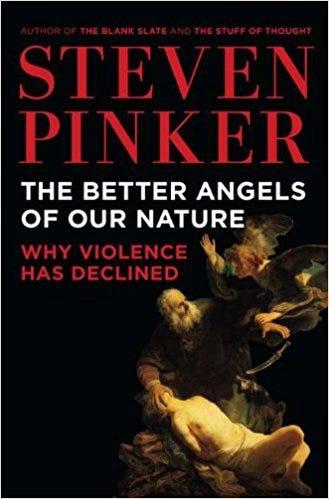 1. _The Better Angels of Our Nature_ by Steven Pinker
1. _The Better Angels of Our Nature_ by Steven Pinker
The world has been steadily getting more peaceful for the past millennium and the 21st century is on track to be the least violent of any in human history. This must be the single most important but least understood fact of modern times. When I tell people this astonishingly positive information, I am almost always greeted not with cheerful acceptance, but hostile disbelief. People are entirely unwilling and moreover seem to not want to believe that the world is actually getting better! The simple reason is while the prevalence of violence has demonstrably been declining, the media coverage of conflict has soared in recent years. Crime and tragic stories drive headlines and human nature tends to place greater weight on negative information leading to a severe misrepresentation of the state of the world among the public. In the midst of this deception, Pinker’s work is a resounding refutation of the media’s worldview. The thesis of this masterpiece is violence has been declining on both a worldwide and individual scale for at least 1000 years and shows no signs of stopping. In case anyone doubts this hypothesis, the first third of the book is devoted to documenting six trends of declining violence with evidence for every trend presented in occasionally excruciating detail. Although Pinker gets caught up in a few too many lists and statistics, the overall message is clear: every kind of conflict, from state-sponsored wars and genocides, to personal violence such as rape and domestic abuse, has declined to historical rates.
What could possibly be driving such an extraordinary movement? Pinker identifies five traits (inner demons) which we have brought under control, four human behaviors that reduce violence (the “better angels” of the title) and five historical factors. Of the three different categories, the five historical forces are the most convincing for explaining the rise of peace and are worth briefly mentioning here:
I. Powerful state governments: known as the Leviathan theory, the idea that strong central ruling bodies reduce violence stretches back to at least 1651 and Thomas Hobbes’ book of the same name. The justice system is often (rightly) maligned but the evidence suggests it does work to reduce crime. The best example is the extraordinary decrease in violent crime in New York since 1990 with an increased police presence and more aggressive tactics. The nearly 90% reduction in crime likely has several factors, but research has demonstrated that adding more police officers (in a data-driven manner) will reduce crime rates. Police and the national military have “a monopoly on the legitimate use of force” which means individual citizens can rely on the state to enforce laws rather than meting out their own punishments. The revenge-driven cycle of violence is cut short by the state-backed authority of the justice system . Despite all their flaws, central governments and police forces create a more civil society because they create and enforce laws that tip the risk-reward balance away from carrying out a crime.
II. Increased trade between countries: In simple economic terms, our neighbors are worth a lot more to us alive than dead. We can trade with any country around the world to acquire resources we may be lacking which is a much better option than launching a war. Moreover, while trade used to revolve around exchanging material goods, which means there was always an option to invade a country to extract its wealth, trade in the 21st century is based on exchanging knowledge, which requires citizens to be alive to to be of any value. Modern technology has significantly decreased the barriers to international trade and the products we use every single day depend on a massive worldwide commerce system that requires us to remain on friendly terms with all participants.
III. Female empowerment: while it may seem superficial to claim that women are less violent than men by nature, Pinker is not shy about admitting there are fundamental biological differences between men and women. These differences are expressed as a decreased predilection for violence on the part of women. Female empowerment means more than just equal rights: it encompasses an entire range of progress, from more women in the workplace to leadership roles at the national level. As women have gained a louder voice in society (although it still is far too repressed), and the rights of females have expanded, they have been able to temper violent inclinations, and as Pinker notes, feminism has been a great benefit to all genders.
IV. Rise and spread of mass culture: the spread of books, movies, television, and information via the internet allows us to experience the world from different cultural perspectives. It is more difficult to perpetrate a crime against someone with whom you identify, and mass media has shown us the common humans traits we all share. It may sound like your high school lit teacher’s fantasy, but reading fiction leads people to be more emphatic to those from different cultures. In decades past, citizens of a country relied on authority figures, such as the government or religious institutions, for information about the outside world. A nation intent on conquering another will portray the citizens of the target country as ruthless savages, a myth that can now be dispelled with a simple internet search that will let us live a day through anyone’s eyes. Mass culture is denigrated for supposedly corrupting our morals, but when it accurately portrays varied cultures, it demonstrates the basic fact that all humans share the same desires, needs, and emotions making it easy for us to see the absurdity in attacking anyone outside (or within) our own culture.
V. Increased reliance on rational thinking: in what is called the “escalator of reason,” western society has shifted the basis for decision-making from superstition to logic. Religions have historical been among the worst perpetrators of conflict from the personal to the national level because are able to justify restrictions to their followers by portraying people of different beliefs as fundamentally inferior (as Voltaire said: “those who can make you belief absurdities can make you commit atrocities”). Through a rational decision-making process we can see this is simply not true and we can play out hypothetical situations where we swap places with those we would hurt. The conclusion from any logical examination of our situation is it makes more sense to cooperate than to fight. Conflict is a zero-sum game, in which one person only gains at the expense of another, but commerce is a positive-sum encounter in which both parties emerge better off. As governments become more secular and laws are passed based on reason rather than superstition, violence is no longer viewed as the primary tactic for conflict resolution.
Overall, The Better Angels of Our Nature was an ideal counterpoint to the doom-and-gloom media stories that dominated the public consciousness in 2017. If we can step back and take the long view, there is still reason for optimism and although an individual year may be a step back, the large-scale trend is forward. However, as Pinker points out, we must keep in mind that this trend does not happen on its own, but is driven by the concerted efforts of individuals and teams who believe in the noble vision of a better world for all. We have a choice between sitting by and idly declaring the world is going to pieces, or we can take action to ensure humanity continues on its peaceful trajectory.
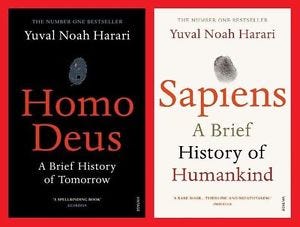 2. _Sapiens: A Brief History of Humankind_ and _Homo Deus: A Brief History of the Future_ by Yuval Harari
2. _Sapiens: A Brief History of Humankind_ and _Homo Deus: A Brief History of the Future_ by Yuval Harari
I enjoy history books that focus not on endless lists of names, dates, and events (which is how history is almost always taught in schools), but on the larger ideas driving progress. These books are not recollections of past events so much as they are “theories of history.” Taken together, Sapiens and Homo Dues take on the fascinating tale of humanity, documenting where we came from and where we can expect to go in the next century. Sapiens records the fascinating tale of humanity, explaining how our species, Homo sapiens, was able to become the dominant creature on Earth. In Harari’s view, our main advantages over all other animals are our communication abilities and our belief in “collective fictions.” The first point is self-explanatory — communication allows us to coordinate efforts and greatly surpass the capabilities of a single individual — but the latter idea is more intriguing. Our largest institutions including nations, religion, money, laws, and corporations do not actually exist. They are entirely fabricated entities that are given power only because many people believe in them. Money is inherently worthless, yet we can exchange it for any goods and services because everyone agrees that it should have value. These unifying myths are able to induce individuals in societies to work together towards massive goals. When enough people buy into a collective fiction, it can affect reality because it is far easier to work together with someone who shares your political or religious beliefs. This is especially true when you are tasked with a project that you may never personally benefit from but that will leave the community as a whole better off. Harari describes how agriculture severely decreased individuals’ well-being but increased the viability of the entire species (Harari calls agriculture “humanity’s biggest fraud’). Unique communication capabilities allowed humans to work together and shared myths motivated us to take on grand projects leading to our conquering of species that individually were stronger and even smarter than Homo sapiens.
Once we find out how we got here, we naturally will want to know where we are going next. Harari takes on this topic in Homo Deus, a fascinating blend of non-fiction concerning our current state and speculative fiction documenting possible futures_._ The initial main argument is in the second half of the 20th century, humanity solved the three big problems of war, plague, and famine that historically occupied our attention every waking moment. Harari summarizes this thesis: “For the first time in history, more people die today from eating too much than from eating too little; more people die from old age than from infectious diseases; and more people commit suicide than are killed by soldiers, terrorists and criminals combined.” Once we accept this idea, we realize the need for some other massive project to occupy us in the 21st century. Harari provides several compelling ideas all under the framework that we will work to surpass our biological human limitations through genetic engineering and human-machine integration. At first, we will use technology to merely correct our inherent deficiencies — think of diseases and birth defects — but it will soon move on to augmenting our abilities. Humans are never satisfied with the current state of the world, and we will not hesitate to bypass evolution in a bid for longer lives with superhuman abilities. Harari is rightly concerned about the implications of engineering our future selves, and also critically examines the implications of developing machine intelligence.
The basic human experience of life can be summed up as follows: we take in information through our senses, process it using a set of rules learned through experience, and produce an output taking the form of action. This is what is known as an algorithm and computers are incredibly good at implementing. We already have computers that far exceed human abilities in domains such as reading medical images and driving vehicles that are simple cases of sensing, processing, acting. The next frontier for machine intelligence is creative pursuits such as writing and music composition which actually are fairly simple acts of pattern recognition and emulation. We have and will continue to improve our lives by harnessing machine intelligence, but Harari also cautions we could be rendered obsolete by computers that far surpass us in mental capabilities leaving masses of unemployed people with nothing to occupy their time. Personally, I think computers and artificial intelligence will not supplant human workers but will allow us to do more valuable work by automating the repetitive tasks we would not want to do anyway. However, it is beneficial to remain skeptical about embracing any new technology without question and Harari’s critical view is always in the back of my mind when I come to rely on Google for yet another daily activity.
Many of the ideas touched on in Homo Deus are intriguing enough that I still find myself thinking about the book six months later, and I have had many great dinner conversations inspired by this book. To take a single example, Harari brings up the topic that we do not know the answer to the seemingly simple question of what makes us happy. He lays out the general equation: happiness = reality — expectations which could explain why as our lives become objectively better, our subjective level of satisfaction has not increased. Moreover, we have two selves: the narrative or remembering self, and the experiencing self. The experiencing self comprises our thoughts and emotions while we are engaged in an activity, while our narrating self weaves individual experiences into our life story. Each self is satisfied by different emotions and therefore to maximize our happiness, each side would tell us to take conflicting actions. Ultimately, the narrator of our lives has far more impact because we spend more time remembering events rather than taking part in them which means that we can gain long-term satisfaction by having experiences that fit into our internal narrative. Our lives are simply stories we tell ourselves, and any meaning or happiness we get derives from how our actions fit into our story. Some people choose to make their story a tragedy, while others like to live a triumph, and all events will be interpreted in the context of a narrative that we get to decide. Homo Deus is not afraid to take on these fundamental questions, and while the book occasionally veers into speculative science fiction, it provides a compelling examination of the human condition and gives a reasoned prediction for the future that seems just plausible enough to come to pass. We often don’t think more than a few days into the future, and it was refreshing to read a work that goes beyond the news cycles, making bold predictions about where we could be heading. Even if Harari turns out to be wrong (and he admits it is possible), the exercise of contemplating the future is critical because it allows us to re-evaluate and correct our actions if we do not like our current path.
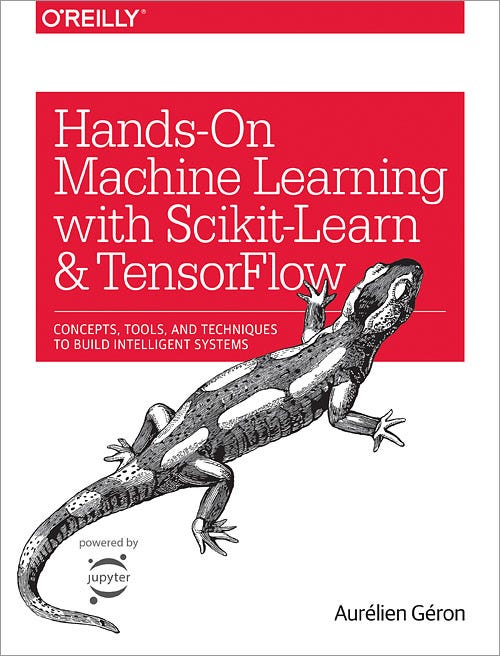 3. _Hands-On Machine Learning with Scikit-Learn and Tensorflow_ by Aurelien Geron
3. _Hands-On Machine Learning with Scikit-Learn and Tensorflow_ by Aurelien Geron
Any textbook is important for the specific topics covered, however, this work makes the list not only for the details, but also for the central tenet that machine learning is both understandable and accessible enough for anyone to learn on their own. Now is an amazing time to get into the machine learning field because there are so many resources available (free of charge) that anyone with a decent laptop and an internet connection can become a skilled machine learning engineer without ever setting foot in a college classroom. The internet has not yet democratized education, but one area it has made accessible for everyone is machine learning and artificial intelligence. Geron emphatically demonstrates this by focusing on two popular, open-source libraries for the Python programming language, Skicit-Learn and TensorFlow. Both libraries (a name for a set of functions you can simply insert into your code so you don’t have to solve a problem that already has a solution) implement state-of-the-art algorithms, but are open for anyone to use and contribute to! I went into the book expecting to be challenged and thought I would give up before I reached the end because the topics would be beyond my abilities. Not only did I make it all the way through, I also completed nearly all of the end-of-chapter exercises and spent many pleasurable hours working through solutions (which Geron provides for free — and constantly updates — on the book’s GitHub page). This is not a reflection of any superior learning ability on my part, but from the straightforward manner in which topics are covered in the book and then implemented in code. Hands-On lives up to its subtitle: “Concepts, Tools, and Techniques to Build Intelligent Systems” as it thoroughly addresses the theory and also includes practical worked-out examples that the reader can then adapt for their own machine learning problems.
Since finishing this book, I have used several of the concepts for both in-class projects and as part of my involvement with a data science research project at Case Western Reserve University. I have also taken graduate level data science and AI courses and found myself far ahead of my peers from this book alone. Again, this is not to emphasize my abilities but to highlight how you can get an education surpassing that of college courses by thoroughly working through resources available to anyone. Furthermore, while I have found the number of options for getting started in a field can be overwhelming and make choosing a place to start difficult, this book alone will get you up to speed in the ideas behind machine learning algorithms and how to implement them in the most popular language for data science. I’ll skip detailing the contents of the book, but it includes chapters on all the relevant ideas in both machine learning and in the increasingly valuable field of artificial intelligence (neural networks). Overall, this book profoundly altered my views on the accessibility of machine learning and has already had a measurable positive impact on my college work and research projects. Geron and other machine learning authors are doing a fantastic job of opening up a vital and exciting field to anyone willing to take the time to study on their own. Hands-On Machine Learning is the most enjoyable textbook I have ever opened, and the only one I have made it through completely on my own for the learning experience.
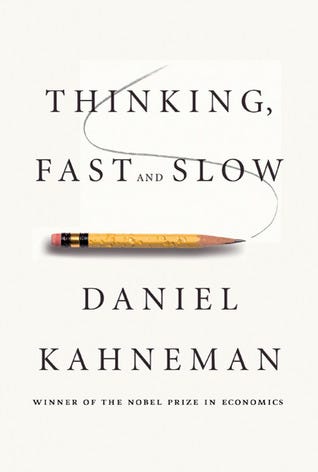 4. _Thinking, Fast and Slow_ by Daniel Kahnemann
4. _Thinking, Fast and Slow_ by Daniel Kahnemann
The central tenet of behavioral economics — that humans do not make completely rational decisions — seems so obvious that it is a wonder it took until 1979 for the field to get started. It was in that year that Kahnemann and his research partner, Amos Tversky, released a paper titled Prospect Theory which described several ways in which humans act against their best interests. Since then, the field has had a profound influence in many areas, from government policy (the “Nudge Unit” in the UK) to professional sports leagues (Billy Beane, the central figure in Moneyball, was taking advantage of many mistakes other managers make). Thinking, Fast and Slow is Kahnemann’s comprehensive summary of the research that gave rise to behavioral economics. At the heart of this research is the idea that humans have two decision-making system, the quick, intuitive system one, and the slower, rational system two. System two is capable of making logical choices, but it is lazy leading to an over reliance on quick judgments from system one. Our fast responses rely on several mental shortcuts, or heuristics, that lead us to make choices against our best interests. The three main heuristics are intriguing enough to warrant mention here:
I. Anchoring refers to our tendency to place too much weight on the first piece of information we hear when making a decision. The best example is when negotiating a price; the first number on the table has an inordinate impact on the final price. We tend to make insufficient adjustments from the initial offer, especially in areas where we have little experience. Kahnemann and Tversky found this effect repeated when answering many numerical questions even when the anchor number had nothing to do with the question.
II. The representativeness bias means we judge an event based on how much it resembles another related event. This leads to errors such as base rate neglect, where we fail to take into account the background probability when evaluating the chance of unlikely events, and the conjunction fallacy where we judge the likelihood of two related events to be more likely than either event by itself, an impossibility. In our daily lives, this causes real harm when we do not consider sample sizes in medical trials, or in the classic gambler’s fallacy, where a gambler who has lost many bets in a row believe they are due for a win.
III. Due to the availability bias, we associate the prevalence of an event by how readily we can recall occurrences of it. People vastly overestimate the dangers of flying because every single plane crash is exhaustively covered by the press whereas mundane dangers such as driving a car is commonplace therefore does not appear in the news. The more vivid the example, the more likely it will be recalled which is why people ignore vast amounts of data in the face of a single personal story.
Behavioral economics may seem to be a collection of academic concepts, but the cognitive mistakes we make have real impacts on our lives such as when we fail to save enough for retirement because we discount the future or continue to poor resources into a negative investment because of the sunk-cost fallacy. However, we are not complete slaves to our error-prone system one, and we can learn to engage system two to make better choices especially in areas where we have little experience or the choice has significant consequences. Kahnemann is careful to not blame system one, as making rapid decisions came in great use at many points in our evolutionary history and continues to help us navigate our lives today. Nevertheless, the decisions we make now are more complex and require processing vast amounts of information, something our ancestors would never have encountered.The next time you need to make a critical decision, make sure to engage your system two, gather as much info as possible, and ideally consult with someone who has more experience in the domain. Academic research can often seem theoretical but Kahnemann makes it accessible, and with how far behavioral economics has crept into modern life, it is crucial that we are able to at least recognize basic fallacies that directly impact our everyday lives.
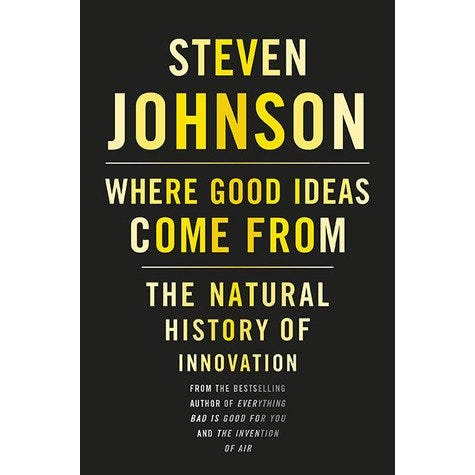 5. _Where Good Ideas Come From_ by Steven Johnson
5. _Where Good Ideas Come From_ by Steven Johnson
The best innovations come not from deep within a narrow field, but from the overlapping areas between domains. Johnson calls this space “the adjacent possible,” where ideas are free to interact and combine. It is the ability to make connections between seemingly disparate research that leads to the greatest innovations and the inventors of a technology are often not the best ones to put it to use because they are focused on a specific use-case that might rather than the area where it can have the largest impact. Moreover, great ideas do not occur instantaneously, but are the product of decades of slow, steady progress. The lone genius in the lab myth is just that, a story told in hindsight that attempts to explain away invention as a magical moment rather than as a drawn out process. The gradual process of discovery is what allow connections between different ideas to be formed. An additional point made in the book is that collaboration is often a greater driver of innovation than competition which can restrict the flow of ideas and prevent concepts from mixing together. Finally, platforms such as the internet that encourage collaboration are fertile grounds for launching new products or technologies that can then build on top of each other. The larger and more diverse the network, the more opportunities for a breakthrough there will be.
How can you have more good ideas? First, surround yourself with a diverse crowd of people who love to share their ideas. Second, work to make connections between adjacent fields rather than getting too fully immersed in a specific area. Finally, don’t be afraid to make mistakes! Many great innovations were the results of what at first appeared to be failures. Alexander Fleming discovered penicillin because a petri dish of bacteria he was working on became contaminated by mold that ended up killing the bacteria. Where are the best places for innovation? The internet and college campuses are ideal for combining new concepts because of the diversity of fields concentrated in one small area. However, make sure not to surround yourself with people who think alike because discussions are another driver of progress. The takeaway from Johnson’s book is that good ideas die in isolation. The more you share and interact, the more ideas will flow around you, and subsequently, you will have a greater chance to harness one of them and turn it into a successful innovation. Don’t be afraid if an idea does not pay off immediately, and keep a wide range of concepts in the back of your mind ready for the right opportunity, platform, or team to take it further. Creativity is certainly part of the idea-creation process, but there are also actionable steps you can take to increase the number of ideas to which you are exposed and hence the innovations you can make. At the very least, if you surround yourself with diverse individuals, you’ll have more interesting conversations!
Without a doubt 2017 was a trying year. However, by switching my source of information from news to books and focusing on the long term rather than the day-to-day incessant shouting of the media, I was able to come out of the year more optimistic about the world. It may seem as if things are going downhill, but at the worst it is a temporary situation that is already showing signs of reversal with recent increases in activism and individuals boldly stepping forward to confront injustice. At the end of 2017 thanks to the books I read, I see the long term trend of humanity continuing towards a more equitable society, I see us using technology to augment our abilities rather than replace us, I see the internet making exciting new careers in machine learning and artificial intelligence accessible to anyone, I see the findings of behavioral economics implemented at the national and individual level to encourage people to make better decisions, and I look forward to taking advantage of the diverse atmosphere of ideas that only a college campus can provide. Our lives are fundamentally shaped by the stories we hear from others and the tales we tell each other, and if we choose to focus on people and teams working to improve the world, we can not only believe in a better future, but work to make it a reality.